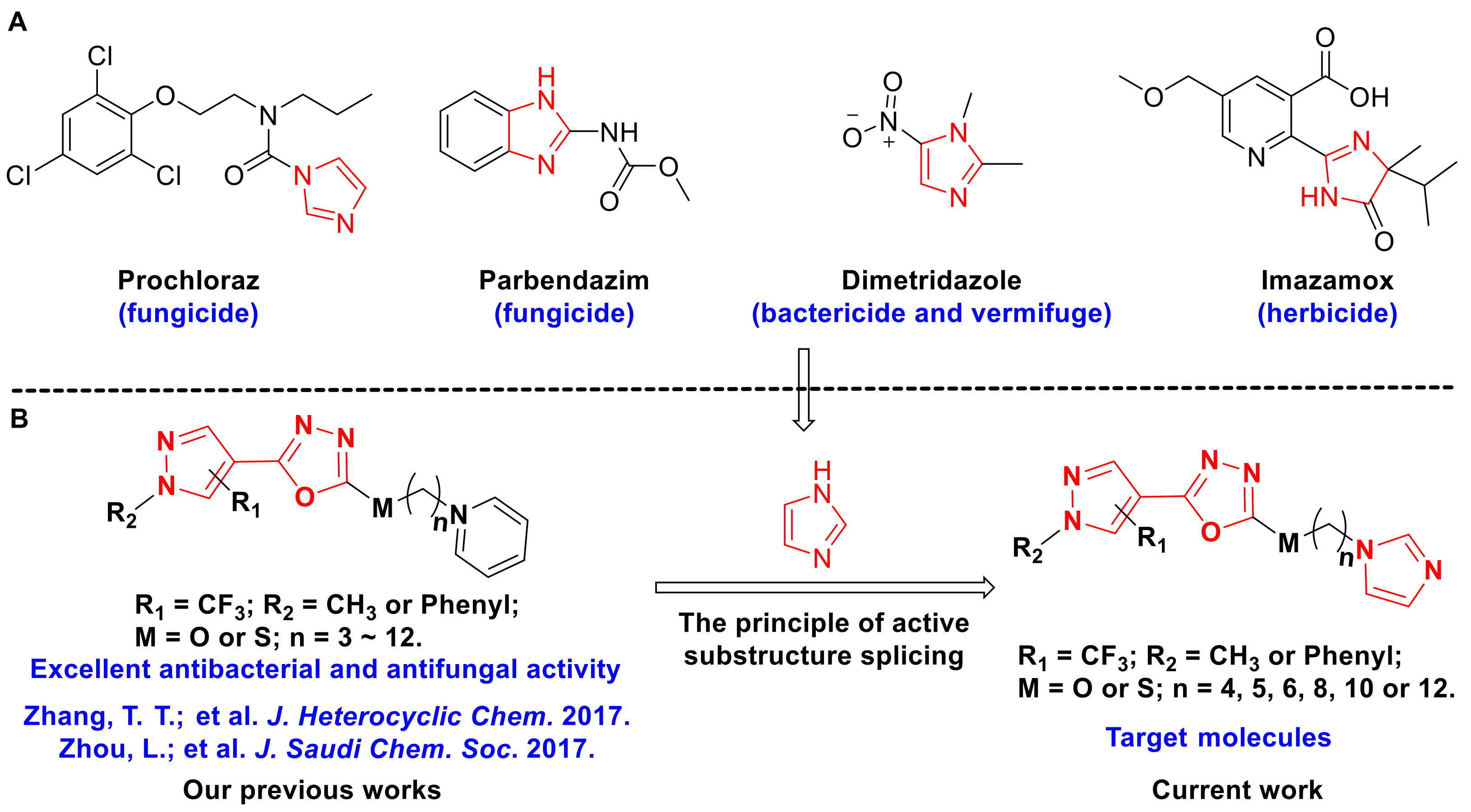Design, Synthesis and Bioactivity Evaluation of Novel 2-(pyrazol-4-yl)-1,3,4-oxadiazoles Containing an Imidazole Fragment as Antibacterial Agents
Abstract
1. Introduction
2. Results and Discussion
2.1. Chemistry
2.2. In Vitro Bioassays against Phytopathogenic Bacteria
2.2.1. Preliminary In Vitro Bioassays
2.2.2. The 50% Effective Concentration (EC50) Test
2.2.3. Structure–Activity Relationship (SAR) Analysis
2.3. In Vivo Bioassays of Compound 7c against Rice Bacterial Blight
2.4. In Vivo Bioassays of Compound 9a against Kiwifruit Bacterial Canker
2.5. Growth Effect of Compound 7c toward Xoo
2.6. Morphological Observation of Xoo Cells by Scanning Electron Microscopy (SEM)
2.7. Membrane Permeability Changes by Propidium Iodide (PI) Staining Experiment
3. Materials and Methods
3.1. Instruments and Chemicals
3.2. Synthesis
3.2.1. General Synthetic Protocols for Target Compounds 7a~7f, 8a~8d and 9a~9d
3.2.2. General Synthetic Protocols for Target Compounds 7a~7f, 8a~8d and 9a~9d
3.3. Bioassays
3.3.1. Methods for General Bioassays
3.3.2. In Vivo Antibacterial Bioassay of Compound 9a against Kiwifruit Bacterial Canker
3.3.3. Growth Effect Assay of Compound 7c against Xoo
3.3.4. Membrane Permeability Changes by Propidium Iodide (PI) Staining Experiment
3.3.5. Data and Statistical Analysis
4. Conclusions
Supplementary Materials
Author Contributions
Funding
Institutional Review Board Statement
Informed Consent Statement
Data Availability Statement
Conflicts of Interest
Sample Availability
References
- Jin, Z. Muscarine, imidazole, oxazole, and thiazole alkaloids. Nat. Prod. Rep. 2011, 28, 1143–1191. [Google Scholar] [CrossRef] [PubMed]
- Tolomeu, H.V.; Fraga, C.A.M. Naturally occurring and synthetic imidazoles: Their chemistry and their biological activities. Molecules 2023, 28, 838. [Google Scholar] [CrossRef] [PubMed]
- Zhang, L.; Peng, X.M.; Damu, G.L.V.; Geng, R.X.; Zhou, C.H. Comprehensive review in current developments of imidazole-based medicinal chemistry. Med. Res. Rev. 2014, 34, 340–437. [Google Scholar] [CrossRef]
- Slassi, S.; Aarjane, M.; Amine, A. Novel triazole derivatives possessing imidazole: Synthesis, spectroscopic characterization (FT-IR, NMR, UV-Vis), DFT studies and antibacterial in vitro evaluation. J. Mol. Struc. 2023, 1276, 134788. [Google Scholar] [CrossRef]
- Liu, H.B.; Lauro, G.; O’Connor, R.D.; Lohith, K.; Kelly, M.; Colin, P.; Bifulco, G.; Bewley, C.A. Tulongicin, an antibacterial tri-indole alkaloid from a deep-water Topsentia sp. sponge. J. Nat. Prod. 2017, 80, 2556–2560. [Google Scholar] [CrossRef]
- Fan, L.; Wei, Y.; Chen, Y.; Jiang, S.; Xu, F.; Zhang, C.; Wang, H.; Shao, X. Epinecidin-1, a marine antifungal peptide, inhibits Botrytis cinerea and delays gray mold in postharvest peaches. Food Chem. 2023, 403, 134419. [Google Scholar] [CrossRef]
- Kovalishyn, V.; Zyabrev, V.; Kachaeva, M.; Ziabrev, K.; Keith, K.; Harden, E.; Hartline, C.; James, S.H.; Brovarets, V. Design of new imidazole derivatives with anti-HCMV activity: QSAR modeling, synthesis and biological testing. J. Comput. Aided Mol. Des. 2021, 35, 1177–1187. [Google Scholar] [CrossRef]
- Kong, T.T.; Zhang, C.M.; Liu, Z.P. Recent developments of p38α MAP kinase inhibitors as anti-inflammatory agents based on the imidazole scaffolds. Curr. Med. Chem. 2013, 20, 1997–2016. [Google Scholar] [CrossRef]
- Basaleh, A.S.; Alomari, F.Y.; Sharfalddin, A.A.; Al-Radadi, N.S.; Domyati, D.; Hussien, M.A. Theoretical investigation by DFT and molecular docking of synthesized oxidovanadium (IV)-based imidazole drug complexes as promising anticancer agents. Molecules 2022, 27, 2796. [Google Scholar] [CrossRef]
- Wei, L.; Li, Q.; Chen, Y.; Zhang, J.; Mi, Y.; Dong, F.; Lei, C.; Guo, Z. Enhanced antioxidant and antifungal activity of chitosan derivatives bearing 6-O-imidazole-based quaternary ammonium salts. Carbohyd. Polym. 2019, 206, 493–503. [Google Scholar] [CrossRef]
- Poyraz, S.; Döndas, H.A.; Sansano, J.M.; Belveren, S.; Yamali, C.; Ülger, M.; Döndas, N.Y.; Saglık, B.N.; Pask, C.M. N-Benzoylthiourea-pyrrolidine carboxylic acid derivatives bearing an imidazole moiety: Synthesis, characterization, crystal structure, in vitro ChEs inhibition, and antituberculosis, antibacterial, antifungal studies. J. Mol. Struct. 2023, 1273, 134303. [Google Scholar] [CrossRef]
- Andreu Rico, A.; Sabater, C.; Castillo, M.Á. Lethal and sub-lethal effects of five pesticides used in rice farming on the earthworm Eisenia fetida. Ecotox. Environ. Saf. 2016, 127, 222–229. [Google Scholar] [CrossRef] [PubMed]
- Hao, W.; Zhong, G.; Hu, M.; Luo, J.; Weng, Q.; Rizwan-ul-Haq, M. Control of citrus postharvest green and blue mold and sour rot by tea saponin combined with imazalil and prochloraz. Postharvest Biol. Technol. 2010, 56, 39–43. [Google Scholar] [CrossRef]
- European Food Safety Authority. Conclusion on the peer review of the pesticide risk assessment of the active substance thiabendazole. EFSA J. 2014, 12, 3880. [Google Scholar]
- Wang, Y.; Fu, L.; Xu, Z.; Ji, S.; Zhuang, P. Determination of Cyazofamid and Its Metabolite in Oily Agricultural Products with HPLC-MS/MS. J. Chromatogr. Sci. 2022, 60, 970–976. [Google Scholar] [CrossRef] [PubMed]
- Song, Y.; Xu, D.; Lu, H.; He, L.; Chen, L.; Shao, J.; Xu, C.; Mu, W.; Liu, F. Baseline sensitivity and efficacy of the sterol biosynthesis inhibitor triflumizole against Botrytis cinerea. Australas. Plant Pathol. 2016, 45, 65–72. [Google Scholar] [CrossRef]
- Liu, B.; Zhu, F.; Huang, Y.; Wang, Y.; Yu, F.; Fan, B.; Yao, J. Screening Rules for Leads of Fungicides, Herbicides, and Insecticides. J. Agric. Food Chem. 2010, 58, 2673–2684. [Google Scholar] [CrossRef]
- Bourakadi, K.E.; Mekhzoum, M.E.M.; Qaiss, A.E.K.; Bouhfid, R. Recent advances in the synthesis and applications of thiabendazole derivatives: A short review. Curr. Org. Chem. 2020, 24, 2367–2377. [Google Scholar] [CrossRef]
- Cronly, M.; Behan, P.; Foley, B.; Malone, E.; Regan, L. Rapid confirmatory method for the determination of 11 nitroimidazoles in egg using liquid chromatography tandem mass spectrometry. J. Chromatogr. A 2009, 1216, 8101–8109. [Google Scholar] [CrossRef]
- Kumbhakar, N.K.; Sanyal, P.K.; Rawte, D.; Kumar, D.; Pal, S. Influence of co-administration of parbendazole on the disposition kinetics and efficacy of albendazole in goats. Indian J. Small Rumin. 2016, 22, 73–77. [Google Scholar] [CrossRef]
- Karuppiah, C.; Babulal, S.M.; Chen, T.-W.; Chen, S.-M.; Hsu, L.-F.; Al Farraj, D.A.; Ramaraj, S.K.; Elshikh, M.S.; Yang, C.C. A novel ammonium zinc molybdate layered double hydroxide nanoflakes/vapor grown carbon fibers nanomaterials based electrocatalyst for the monitoring of dimetridazole drug in real samples. J. Environ. Chem. Eng. 2022, 10, 108227. [Google Scholar] [CrossRef]
- Yadav, R.; Bhullar, M.S.; Kaur, S.; Kaur, T.; Jhala, A.J. Weed control in conventional soybean with pendimethalin followed by imazethapyr plus imazamox/quizalofop-p-ethyl. Can. J. Plant Sci. 2017, 97, 654–664. [Google Scholar]
- Lamberth, C. Imidazole chemistry in crop protection. Heterocycles 2021, 102, 1449–1477. [Google Scholar] [CrossRef]
- Ningaiah, S.; Bhadraiah, U.K.; Doddaramappa, S.D.; Keshavamurthy, S.; Javarasetty, C. Novel pyrazole integrated 1,3,4-oxadiazoles: Synthesis, characterization and antimicrobial evaluation. Bioorg. Med. Chem. Lett. 2014, 24, 245–248. [Google Scholar] [CrossRef]
- Prakash, O.; Kumar, M.; Kumar, R.; Sharma, C.; Aneja, K.R. Hypervalent iodine(III) mediated synthesis of novel unsymmetrical 2,5-disubstituted 1,3,4-oxadiazoles as antibacterial and antifungal agents. Eur. J. Med. Chem. 2010, 45, 4252–4257. [Google Scholar] [CrossRef]
- Karad, S.C.; Purohit, V.B.; Avalani, J.R.; Sapariya, N.H.; Raval, D.K. Design, synthesis and characterization of fluoro substituted novel pyrazole nucleus clubbed with 1,3,4-oxadiazole scaffolds and their biological applications. RSC Adv. 2016, 6, 41532–41541. [Google Scholar] [CrossRef]
- Shamroukh, A.H.; Rashad, A.E.; Ali, H.S.; Awad, S.M. Studies on the reactivity of amino-1-(6-phenyl-pyridazin-3-yl)-1H-pyrazole-4-carboxylic acid hydrazide towards some reagents for biological evaluation. J. Heterocycl. Chem. 2014, 51, 899–905. [Google Scholar] [CrossRef]
- Rai, N.P.; Narayanaswamy, V.K.; Shashikanth, S.; Arunachalam, P.N. Synthesis, characterization and antibacterial activity of 2-[1-(5-chloro-2-methoxy-phenyl)-5-methyl-1H-pyrazol-4-yl]-5-(substituted-phenyl)-[1,3,4]oxadiazoles. Eur. J. Med. Chem. 2009, 44, 4522–4527. [Google Scholar] [CrossRef]
- Lee, S.H.; Seo, H.J.; Kim, M.J.; Kang, S.; Lee, S.H.; Ahn, K.; Lee, M.W.; Han, H.K.; Kim, J.; Lee, J. Pentacycle derivatives as cannabinoid CB1 receptor ligands. Bioorg. Med. Chem. Lett. 2009, 19, 6632–6636. [Google Scholar] [CrossRef]
- Abu-Zaied, M.A.; El-Telbani, E.M.; Elgemeie, G.H.; Nawwar, G.A.M. Synthesis and in vitro anti-tumor activity of new oxadiazole thioglycosides. Eur. J. Med. Chem. 2011, 46, 229–235. [Google Scholar] [CrossRef]
- El-Miligy, M.M.; Hazzaa, A.A.; El-Messmary, H.; Nassra, R.A.; El-Hawash, S.A. New benzothiophene derivatives as dual COX-1/2 and 5-LOX inhibitors: Synthesis, biological evaluation and docking study. Future Med. Chem. 2017, 9, 443–468. [Google Scholar] [CrossRef] [PubMed]
- Selvakumar, B.; Vaidyanathan, S.P.; Madhuri, S.; Elango, K.P. Synthesis and antiviral activity of sulfonohydrazide and 1,3,4-oxadiazole derivatives of 6,6-dimethyl-9-oxo-4,5,6,7,8,9-hexahydropyrazolo[5,1-b] quinazoline. J. Chem. Res. 2017, 41, 221–224. [Google Scholar] [CrossRef]
- Kumar, M.; Kumar, V.; Beniwal, V. Synthesis of some pyrazolylaldehyde N-isonicotinoyl hydrazones and 2,5-disubstituted 1,3,4-oxadiazoles as DNA photocleaving agents. Med. Chem. Res. 2015, 24, 2862–2870. [Google Scholar] [CrossRef]
- Zhang, X.M.; Yang, Z.; Xu, H.; Liu, Y.; Yang, X.; Sun, T.; Lu, X.; Shi, F.; Yang, Q.; Chen, W.; et al. Synthesis, Antifungal Activity, and 3D-QASR of Novel 1,2,3,4-Tetrahydroquinoline Derivatives Containing a Pyrimidine Ether Scaffold as Chitin Synthase Inhibitors. J. Agric. Food Chem. 2022, 70, 9262–9275. [Google Scholar] [CrossRef] [PubMed]
- Zeng, F.; Lu, T.; Wang, J.; Nie, X.; Xiong, W.; Yin, Z.; Peng, D. Design, Synthesis and Bioactivity Evaluation of Coumarin–BMT Hybrids as New Acetylcholinesterase Inhibitors. Molecules 2022, 27, 2142. [Google Scholar] [CrossRef] [PubMed]
- Wu, H.; Lu, X.; Xu, J.; Zhang, X.; Li, Z.; Yang, X.; Ling, Y. Design, Synthesis and Fungicidal Activity of N-(thiophen-2-yl) Nicotinamide Derivatives. Molecules 2022, 27, 8700. [Google Scholar] [CrossRef]
- Zhou, L.; Wang, P.Y.; Zhou, J.; Shao, W.B.; Fang, H.S.; Wu, Z.B.; Yang, S. Antimicrobial activities of pyridinium-tailored pyrazoles bearing 1,3,4-oxadiazole scaffolds. J. Saudi Chem. Soc. 2017, 21, 852–860. [Google Scholar] [CrossRef]
- Zhang, T.T.; Wang, P.Y.; Zhou, J.; Shao, W.B.; Fang, H.S.; Zhou, X.; Wu, Z.B. Antibacterial and antifungal activities of 2-(substituted ether)-5-(1-phenyl-5-(trifluoromethyl)-1H-pyrazol-4-yl)-1,3,4-oxadiazole derivatives. J. Heterocycl. Chem. 2017, 54, 2319–2325. [Google Scholar] [CrossRef]
- Zhao, Y.L.; Huang, X.; Liu, L.W.; Wang, P.Y.; Long, Q.S.; Tao, Q.Q.; Li, Z.; Yang, S. Identification of racemic and chiral carbazole derivatives containing an isopropanolamine linker as prospective surrogates against plant pathogenic bacteria: In vitro and in vivo assays and quantitative proteomics. J. Agric. Food Chem. 2019, 67, 7512–7525. [Google Scholar] [CrossRef]
- Wang, M.W.; Zhu, H.H.; Wang, P.Y.; Zeng, D.; Wu, Y.Y.; Liu, L.W.; Wu, Z.B.; Li, Z.; Yang, S. Synthesis of thiazolium-labeled 1, 3, 4-oxadiazole thioethers as prospective antimicrobials: In vitro and in vivo bioactivity and mechanism of action. J. Agric. Food Chem. 2019, 67, 12696–12708. [Google Scholar] [CrossRef]
- Wang, F.; Yang, B.X.; Zhang, T.H.; Tao, Q.Q.; Zhou, X.; Wang, P.Y.; Yang, S. Novel 1, 3, 4-Oxadiazole Thioether and Sulfone Derivatives Bearing a Flexible N-Heterocyclic Moiety: Synthesis, Characterization, and Anti-microorganism Activity. Arab. J. Chem. 2022, 16, 104479. [Google Scholar] [CrossRef]
- Song, Y.L.; Liu, H.W.; Yang, Y.H.; He, J.J.; Yang, B.X.; Yang, L.L.; Zhou, X.; Liu, L.W.; Wang, P.Y.; Yang, S. Novel 18β-glycyrrhetinic acid amide derivatives show dual-acting capabilities for control of plant bacterial diseases through ROS-mediated antibacterial efficiency and activation of plant defense responses. J. Integr. Agric. 2022. [Google Scholar] [CrossRef]
- Zhu, X.F.; Xu, Y.; Peng, D.; Zhang, Y.; Huang, T.T.; Wang, J.X.; Zhou, M.G. Detection and characterization of bismerthiazol-resistance of Xanthomonas oryzae pv. Oryzae. Crop. Prot. 2013, 47, 24–29. [Google Scholar] [CrossRef]
- Feng, C.; Zhang, C.; Kong, F.; Wang, J. Synthesis of thiodiazole copper microcapsules and release behavior of inhibiting R. solanacearum. RSC Adv. 2014, 4, 4478–4486. [Google Scholar] [CrossRef]
- Wang, P.Y.; Wang, M.W.; Zeng, D.; Xiang, M.; Rao, J.R.; Liu, Q.Q.; Liu, L.W.; Wu, Z.B.; Li, Z.; Song, B.A.; et al. Rational Optimization and Action Mechanism of Novel Imidazole (or Imidazolium)-Labeled 1,3,4-Oxadiazole Thioethers as Promising Anti-bacterial Agents against Plant Bacterial Diseases. J. Agric. Food Chem. 2019, 67, 3535–3545. [Google Scholar] [CrossRef] [PubMed]
- Xiong, G.; Wu, Z.; Yi, J.; Fu, L.; Yang, Z.; Hsieh, C.; Yin, M.; Zeng, X.; Wu, C.; Lu, A.; et al. ADMETlab 2.0: An integrated online platform for accurate and comprehensive predictions of ADMET properties. Nucleic Acids Res. 2021, 49, 5–14. [Google Scholar] [CrossRef]
- Liu, H.W.; Ji, Q.T.; Ren, G.G.; Wang, F.; Su, F.; Wang, P.Y.; Zhou, X.; Wu, Z.B.; Li, Z.; Yang, S. Antibacterial functions and proposed modes of action of novel 1,2,3,4-tetrahydro-β-carboline derivatives that Possess an attractive 1,3-diaminopropan-2-ol pattern against rice bacterial blight, kiwifruit bacterial canker, and citrus bacterial canker. J. Agric. Food Chem. 2020, 68, 12558–12568. [Google Scholar] [CrossRef]
- Huang, X.; Liu, H.W.; Long, Z.Q.; Li, Z.X.; Zhu, J.J.; Wang, P.Y.; Qi, P.Y.; Liu, L.W.; Yang, S. Rational optimization of 1,2,3-triazole-tailored carbazoles as prospective antibacterial alternatives with significant in vivo control efficiency and unique mode of action. J. Agric. Food Chem. 2021, 69, 4615–4627. [Google Scholar] [CrossRef]
- Wang, F.; Liu, H.W.; Zhang, L.; Liu, S.T.; Zhang, J.R.; Zhou, X.; Wang, P.Y.; Yang, S. Discovery of novel rost-4-ene derivatives as potential plant activators for preventing phytopathogenic bacterial infection: Design, synthesis and biological studies. Pest Manag. Sci. 2022, 78, 3404–3415. [Google Scholar] [CrossRef]
- Dong, Z.; Xing, S.; Liu, J.; Tang, X.; Ruan, L.; Sun, M.; Tong, Y.; Peng, D. Isolation and characterization of a novel phage Xoo-sp2 that infects Xanthomonas oryzae pv. oryzae. J. Gen. Virol. 2018, 99, 1453–1462. [Google Scholar] [CrossRef]
- Faerber, N.; Reitler, J.; Kamenac, A.; Westerhausen, C. Shear stress induced lipid order and permeability changes of giant unilamellar vesicles. Biochim. Biophys. Acta BBA Gen. Subj. 2022, 1866, 130199. [Google Scholar] [CrossRef]
- Hammoudi Halat, D.; Younes, S.; Mourad, N.; Rahal, M. Allylamines, Benzylamines, and Fungal Cell Permeability: A Review of Mechanistic Effects and Usefulness against Fungal Pathogens. Membranes-Basel. 2022, 12, 1171. [Google Scholar] [CrossRef] [PubMed]
- Bor, B.; Cen, L.; Agnello, M.; Shi, W.; He, X. Morphological and physiological changes induced by contact-dependent interaction between Candida albicans and Fusobacterium nucleatum. Sci. Rep. 2016, 6, 27956. [Google Scholar] [CrossRef] [PubMed]
- Khan, N.A.; Rashid, F.; Jadoon, M.S.K.; Jalil, S.; Khan, Z.A.; Orfali, R.; Perveen, S.; Al-Taweel, A.; Iqbal, J.; Shahzad, S.A. Design, Synthesis, and Biological Evaluation of Novel Dihydropyridine and Pyridine Analogs as Potent Human Tissue Nonspecific Alkaline Phosphatase Inhibitors with Anticancer Activity: ROS and DNA Damage-Induced Apoptosis. Molecules 2022, 27, 6235. [Google Scholar] [CrossRef] [PubMed]
- Li, J.L.; Liu, X.Y.; Xie, J.T.; Di, Y.L.; Zhu, F.X. A Comparison of Different Estimation Methods for Fungicide EC50 and EC95 Values. J. Phytopathol. 2014, 163, 239–244. [Google Scholar] [CrossRef]
- Duncan, D.B. Multiple range and multiple F tests. Biometrics 1955, 11, 1–42. [Google Scholar] [CrossRef]
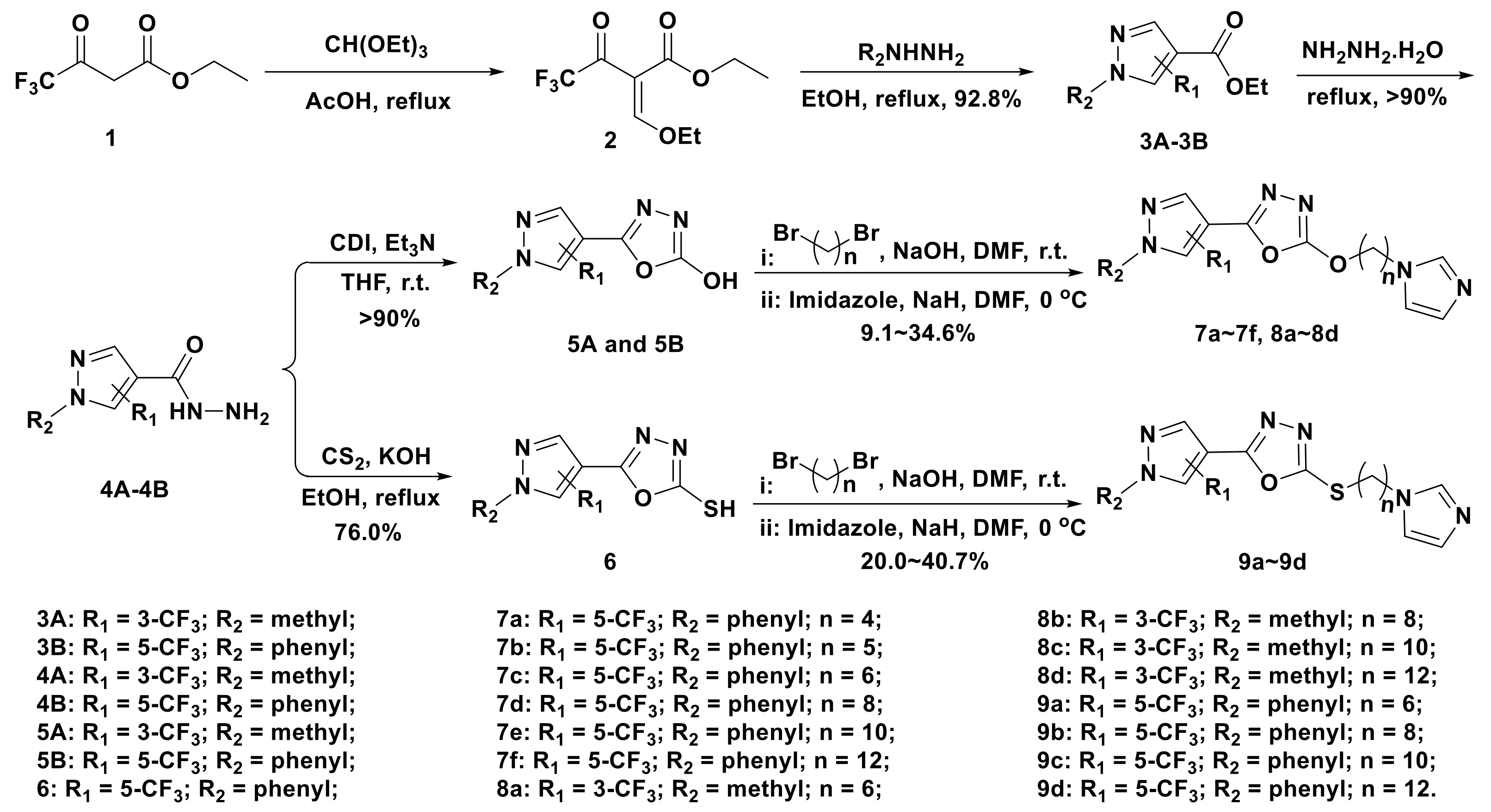

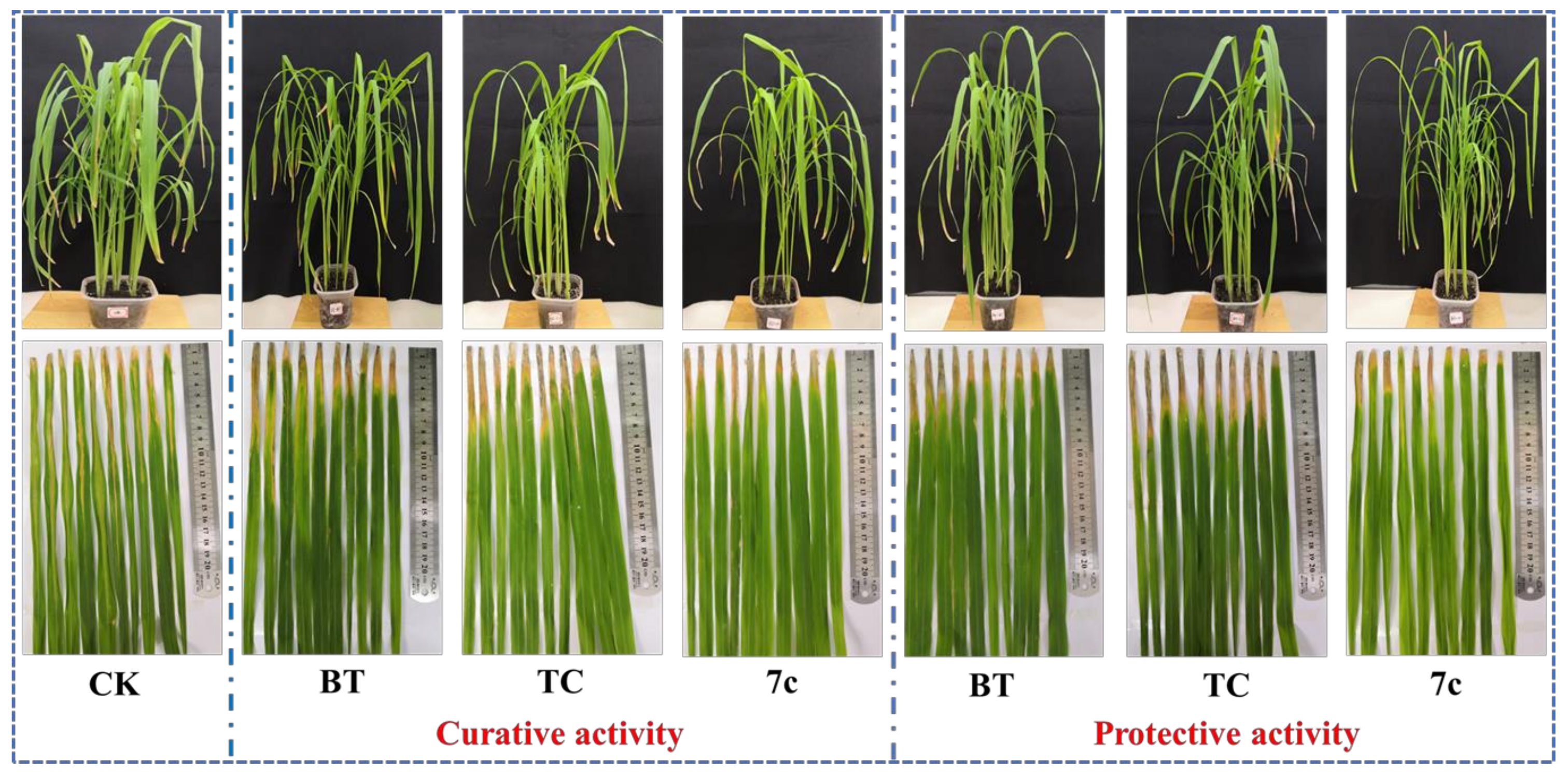
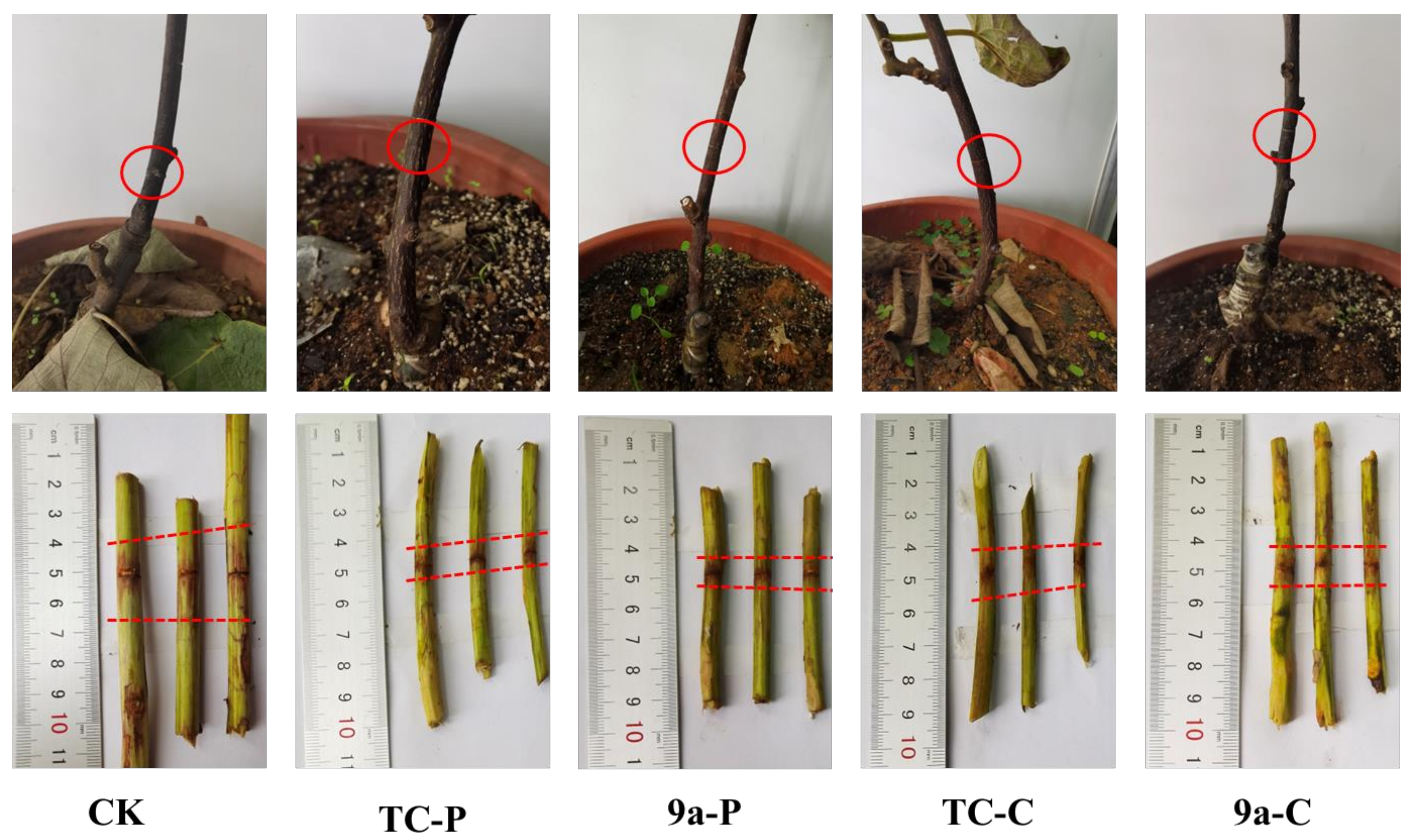
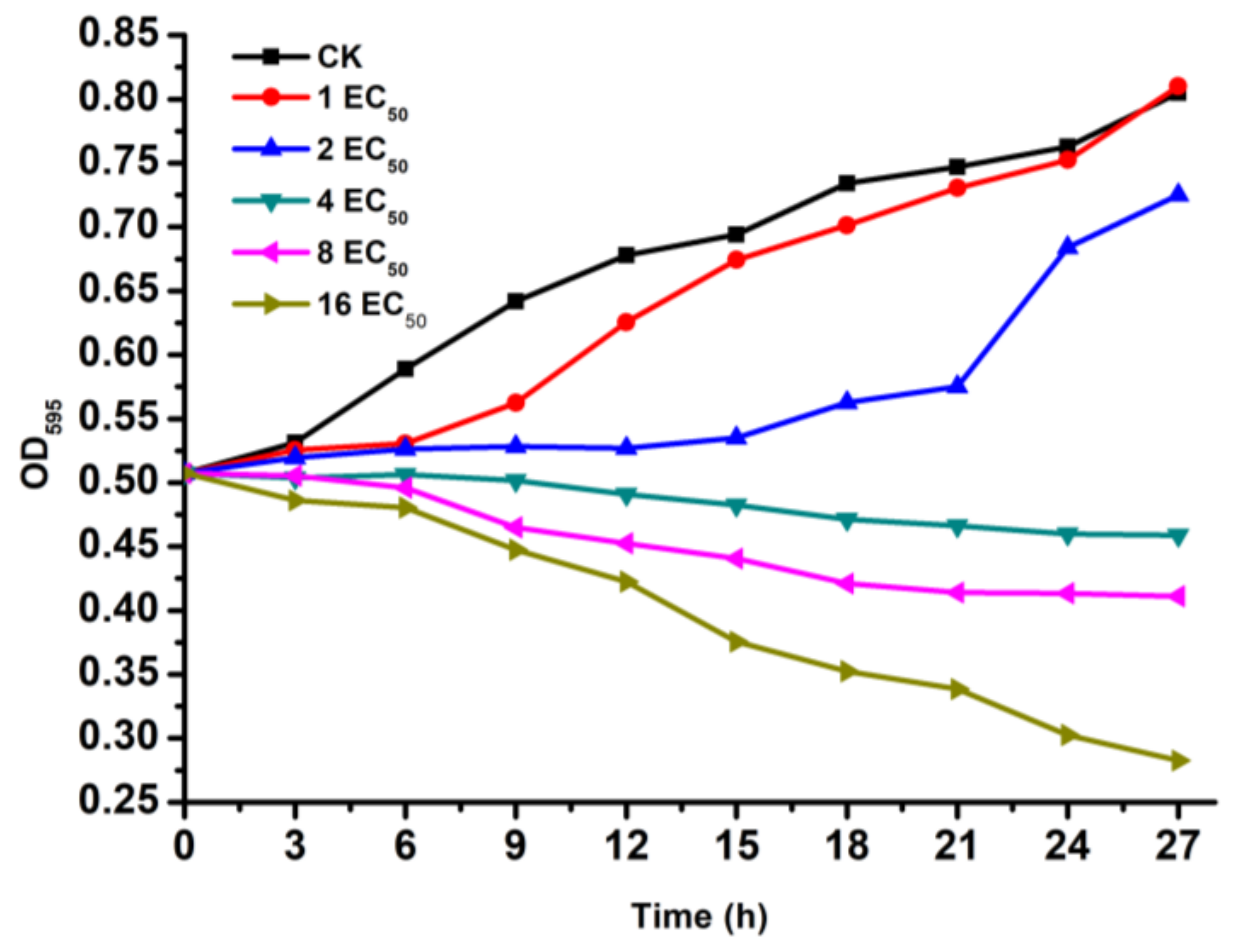

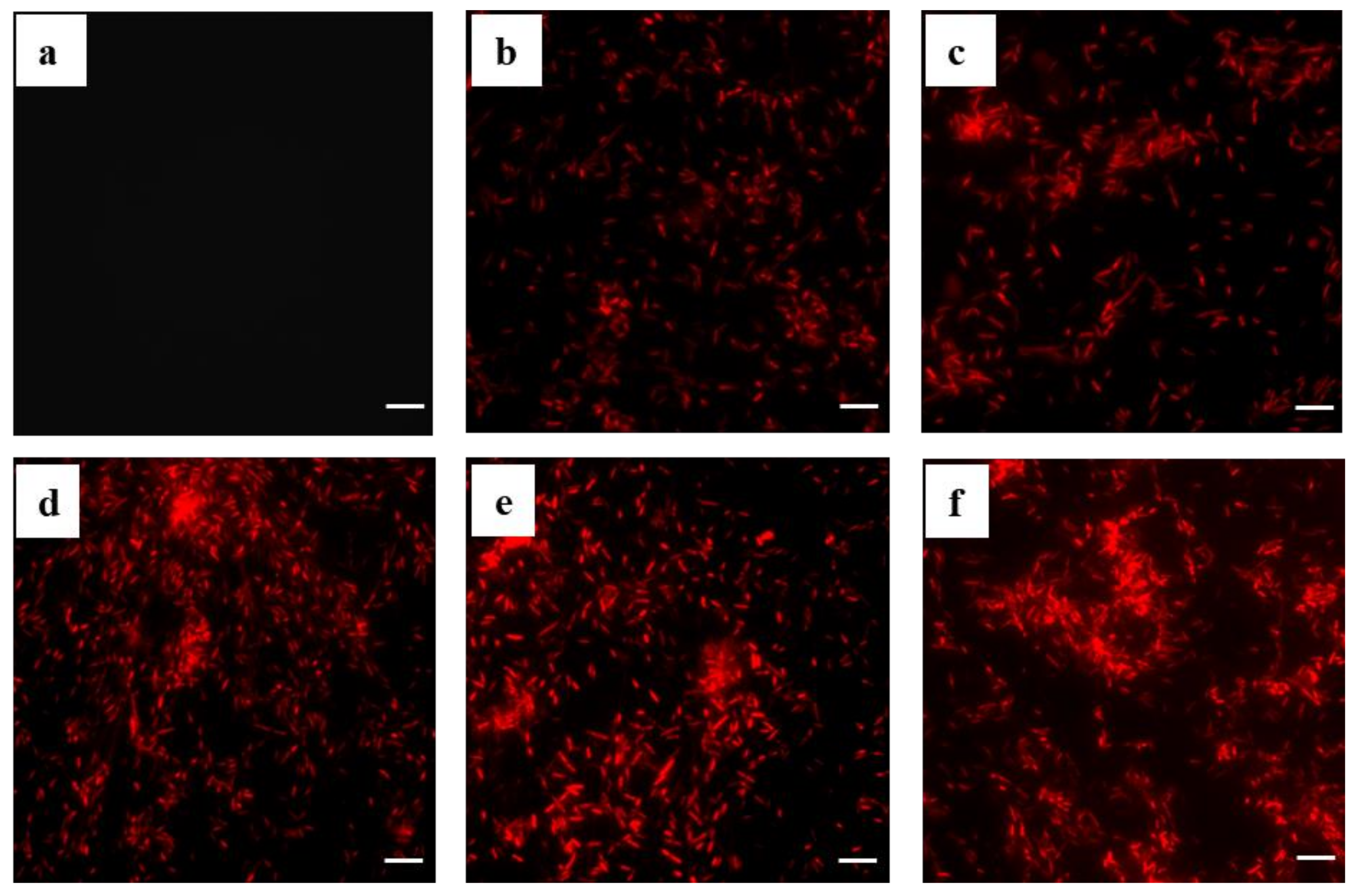
| Compd. | Xooa | Xaca | Psaa | |||
|---|---|---|---|---|---|---|
| 100 μg/mL | 50 μg/mL | 100 μg/mL | 50 μg/mL | 100 μg/mL | 50 μg/mL | |
| 7a | 100 | 100 | 100 | 88.54 ± 1.24 | 76.40 ± 2.59 | 56.93 ± 2.47 |
| 7b | 100 | 100 | 100 | 100 | 70.20 ± 3.23 | 63.90 ± 3.38 |
| 7c | 100 | 100 | 90.59 ± 1.03 | 86.44 ± 0.77 | 62.94 ± 3.47 | 46.51 ± 0.21 |
| 7d | 100 | 100 | 86.13 ± 0.43 | 49.72 ± 0.57 | 59.89 ± 2.43 | 44.99 ± 0.29 |
| 7e | 80.73 ± 3.50 | 71.90 ± 1.21 | 82.41 ± 2.21 | 67.68 ± 1.67 | 49.47 ± 2.50 | 43.84 ± 3.02 |
| 7f | 66.30 ± 3.57 | 24.45 ± 3.97 | 22.29 ± 1.67 | 16.78 ± 0.81 | 59.31 ± 1.74 | 45.85 ± 2.17 |
| 8a | 21.34 ± 1.73 | 0 | 46.44 ± 3.47 | 36.41± 6.33 | 47.56 ± 0.76 | 26.84 ± 2.75 |
| 8b | 100 | 78.27 ± 1.09 | 100 | 100 | 72.49 ± 2.23 | 44.98 ± 1.62 |
| 8c | 100 | 100 | 100 | 100 | 72.64 ± 1.02 | 61.51 ± 0.21 |
| 8d | 100 | 100 | 67.18 ± 2.90 | 38.95 ± 2.61 | 64.18 ± 4.45 | 47.85 ± 3.38 |
| 9a | 100 | 100 | 100 | 100 | 78.45 ± 3.72 | 65.87 ± 1.25 |
| 9b | 100 | 100 | 88.05 ± 1.78 | 87.37 ± 2.41 | 46.13 ± 0.20 | 16.71 ± 2.43 |
| 9c | 55.70 ± 4.40 | 60.88 ± 0.33 | 19.69 ± 1.02 | 18.95 ± 1.54 | 54.87 ± 0.20 | 40.21 ± 3.58 |
| 9d | 58.57 ± 2.41 | 27.03 ± 3.96 | 45.94 ± 0.17 | 39.07 ± 0.93 | 37.07 ± 1.96 | 32.66 ± 4.86 |
| TC | 51.04 ± 2.14 | 38.81 ± 2.25 | 57.94 ± 2.67 | 36.17 ± 0.30 | 57.31 ± 0.80 | 46.57 ± 1.99 |
| BT | 100 | 100 | 99.84 ± 0.27 | 49.45 ± 2.16 | 24.73 ± 0.23 | 3.17 ± 3.12 |
| Comp. | Xoo | Xac | Psa | |||
|---|---|---|---|---|---|---|
| EC50 (μg/mL) a | EC50 (μM) a | EC50 (μg/mL) | EC50 (μM) | EC50 (μg/mL) | EC50 (μM) | |
| 7a | 7.73 ± 1.25 f | 18.44 ± 1.51 e | 41.69 ± 0.59 c | 99.47 ± 1.42 c | 40.71 ± 0.09 c | 97.13 ± 0.21 c |
| 7b | 10.23 ± 0.20 def | 23.61 ± 0.46 de | 30.26 ± 1.85 d | 69.87 ± 4.28 d | 28.40 ± 1.53 d | 65.56 ± 3.90 d |
| 7c | 7.40 ± 1.26 f | 16.55 ± 2.81 e | 11.22 ± 0.09 e | 25.09 ± 0.19 e | >50 | >100 |
| 7d | 7.95 ± 0.12 f | 16.72 ± 0.27 e | >50 | >100 | >50 | >100 |
| 7e | 8.78 ± 0.31 ef | 17.46 ± 0.70 e | 36.63 ± 0.71 cd | 72.79 ± 1.42 d | >50 | >100 |
| 7f | >50 | >100 | >50 | >100 | >50 | >100 |
| 8a | >50 | >100 | >50 | >100 | >50 | >100 |
| 8b | 20.25 ± 0.41 c | 49.01 ± 0.99 c | 10.91 ± 0.36 e | 26.40 ± 0.84 e | >50 | >100 |
| 8c | 14.71 ± 0.22 d | 33.33 ± 0.50 d | 8.72 ± 1.20 e | 19.76 ± 1.00 e | 35.24 ± 1.58 cd | 79.87 ± 3.58 cd |
| 8d | 8.44 ± 0.54 ef | 17.99 ± 0.78 e | >50 | >100 | >50 | >100 |
| 9a | 12.40 ± 0.13 de | 26.77 ± 0.25 de | 5.44 ± 0.39 e | 11.76 ± 0.65 e | 12.85 ± 1.42 e | 27.75 ± 3.07 e |
| 9b | 8.13 ± 0.51 f | 16.56 ± 0.72 e | 10.84 ± 0.32 e | 22.08 ± 0.83 e | >50 | >100 |
| 9c | 27.26 ± 1.65 b | 52.51 ± 3.17 c | >50 | >100 | >50 | >100 |
| 9d | >50 | >100 | >50 | >100 | >50 | >100 |
| TC | 76.81 ± 2.22 a | 234.16 ± 6.76 a | 66.98 ± 0.49 a | 204.21 ± 1.49 a | 74.98 ± 3.49 b | 228.59 ± 10.64 b |
| BT | 31.94 ± 3.59 b | 97.85 ± 4.25 b | 50.51 ± 2.08 b | 154.73 ± 6.35 b | 114.76 ± 3.93 a | 351.56 ± 12.03 a |
| Chemicals | Protective Activity | Curative Activity | ||||
|---|---|---|---|---|---|---|
| Morbidity (%) | Disease Index (%) | Control Efficiency (%) a | Morbidity (%) | Disease Index (%) | Control Efficiency (%) a | |
| 7c | 100 | 39.78 | 47.34 a | 100 | 44.44 | 41.18 a |
| BT | 100 | 39.08 | 48.28 a | 100 | 51.85 | 31.37 b |
| TC | 100 | 49.02 | 35.12 b | 100 | 47.22 | 37.50 a |
| CK | 100 | 75.56 | 100 | 75.56 | ||
| Chemicals a | Measured Lesion Length (mm) | Corrected Lesion Length (mm) | Control Efficiency (%) b | ||||
|---|---|---|---|---|---|---|---|
| 9a-P | 9 | 7 | 7.5 | 8 | 6 | 6.5 | 46.05 ± 8.22 a |
| 9a-C | 9.5 | 9 | 10 | 8.5 | 8 | 9 | 32.89 ± 3.95 b |
| TC-P | 9.5 | 9.5 | 10 | 8.5 | 8.5 | 9 | 31.58 ± 2.28 b |
| TC-C | 9.5 | 13 | 12 | 8.5 | 12 | 11 | 17.11 ± 5.58 c |
| CK | 15 | 14.5 | 11.5 | 14 | 13.5 | 10.5 | |
Disclaimer/Publisher’s Note: The statements, opinions and data contained in all publications are solely those of the individual author(s) and contributor(s) and not of MDPI and/or the editor(s). MDPI and/or the editor(s) disclaim responsibility for any injury to people or property resulting from any ideas, methods, instructions or products referred to in the content. |
© 2023 by the authors. Licensee MDPI, Basel, Switzerland. This article is an open access article distributed under the terms and conditions of the Creative Commons Attribution (CC BY) license (https://creativecommons.org/licenses/by/4.0/).
Share and Cite
Liu, H.; Yang, S.; Li, T.; Ma, S.; Wang, P.; Wang, G.; Su, S.; Ding, Y.; Yang, L.; Zhou, X.; et al. Design, Synthesis and Bioactivity Evaluation of Novel 2-(pyrazol-4-yl)-1,3,4-oxadiazoles Containing an Imidazole Fragment as Antibacterial Agents. Molecules 2023, 28, 2442. https://doi.org/10.3390/molecules28062442
Liu H, Yang S, Li T, Ma S, Wang P, Wang G, Su S, Ding Y, Yang L, Zhou X, et al. Design, Synthesis and Bioactivity Evaluation of Novel 2-(pyrazol-4-yl)-1,3,4-oxadiazoles Containing an Imidazole Fragment as Antibacterial Agents. Molecules. 2023; 28(6):2442. https://doi.org/10.3390/molecules28062442
Chicago/Turabian StyleLiu, Hongwu, Shan Yang, Ting Li, Siyue Ma, Peiyi Wang, Guoqing Wang, Shanshan Su, Yue Ding, Linli Yang, Xiang Zhou, and et al. 2023. "Design, Synthesis and Bioactivity Evaluation of Novel 2-(pyrazol-4-yl)-1,3,4-oxadiazoles Containing an Imidazole Fragment as Antibacterial Agents" Molecules 28, no. 6: 2442. https://doi.org/10.3390/molecules28062442
APA StyleLiu, H., Yang, S., Li, T., Ma, S., Wang, P., Wang, G., Su, S., Ding, Y., Yang, L., Zhou, X., & Yang, S. (2023). Design, Synthesis and Bioactivity Evaluation of Novel 2-(pyrazol-4-yl)-1,3,4-oxadiazoles Containing an Imidazole Fragment as Antibacterial Agents. Molecules, 28(6), 2442. https://doi.org/10.3390/molecules28062442




